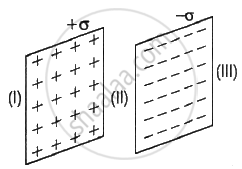Advertisements
Advertisements
प्रश्न
Solve numerical example.
A potential difference of 5000 volts is applied between two parallel plates 5cm apart a small oil drop having a charge of 9.6 ×10-19 C falls between the plates. Find
- electric field intensity between the plates and
- the force on the oil drop.
उत्तर
Given: V = 5000 volts, d = 5 cm = 5 × 10-2 m, q = 9.6 × 10-19 C
To find: a. Electric field intensity (E)
b. Force (F)
Formulae: i. E = `"V"/"d"`
ii. E = `"F"/"q"`
Calculation: From formula (i),
E = `5000/(5xx10^-2)` = 105 N/C
From formula (ii)
F = E × q
= 105 × 9.6 × 10-19
= 9.6 × 10-14 N
- Electric field intensity between the plates is 105 N/C
- Force on the oil drop is 9.6 × 10-14 N
APPEARS IN
संबंधित प्रश्न
Choose the correct option.
Which of the following produces uniform electric field?
Answer the following question.
What is a uniform electric field?
Answer the following question.
If two lines of force intersect of one point. What does it mean?
A conducting sphere of radius R = 20 cm is given a charge Q = 16 µC. What is `vecE` at centre?
The number of electrons to be put on a spherical conductor of radius 0.1 m to produce an electric field of 0.036 N/C just above its surface is ____________.
An electron is moving towards X-axis. An electric field is along Y-direction then path of electron is ____________.
An electron experiences a force equal to its weight, when placed in an electric field. The intensity of the field will be ______.
Radius of a metal sphere is 4 cm. It is given a charge of 8 µC. The force acting on unit area of its surface is ____________.
Deuteron and `alpha` - particle are put 1 Å apart in air. Magnitude of intensity of electric field due to deuteron at `alpha` - particle is ____________.
The magnitude of point charge due to which the electric field 30 cm away has the magnitude 2 NC-1 will be ____________.
Two parallel plates separated by 'd' mm are kept at potential difference of 'V' volt. A particle of mass 'm' and charge 'q' enters in it with some velocity. The acceleration of the particle will be ______.
A particle of mass m and charge q is placed at rest in a uniform electric field E and then released, the kinetic energy attained by the particle after moving a distance y will be ______.
Electric field at the centroid of a triangle carrying q charge at each comer as
Dimensional formula for electrical field is ______
A charged particle (mass m and charge q) moves along X axis with velocity V0. When it passes through the origin it enters a region having uniform electric field `vec"E" = -"E"hat"j"` which extends upto x = d. Equation of path of electron in the region x > d is :

A copper ball of density 8.6 g/cm3, 1 cm in diameter is immersed in oil of density 0.8 glcm3. The charge in µC on the ball, if it remains just suspended in an electric field of intensity 3600 V/m acting in upward direction is ______ µC.
The magnitude of the average electric field normally present in the atmosphere just above the surface of the Earth is about 150 N/C, directed inward towards the center of the Earth. This gives the total net surface charge carried by the Earth to be:
[Given: ε0 = 8.85 × 10-12 C2/N-m2, RE = 6.37 × 106m]
The electric field in a region of space is given by, `vec"E"= "E"_"o"hat"i" + 2"E"_"o"hat"j"` where Eo = 100 N/C. The flux of the field through a circular surface of radius 0.02 m parallel to the Y-Z plane is nearly ______.
The expression for electric field intensity at a point outside uniformly charged thin plane sheet is ______. (d is the distance of point from plane sheet)
Consider the following statement about the electric field the intensity and the electric potential.
- The electric field intensity due to a charged spherical shell is inversely proportional to the square of its radius.
- The electric potential due to a point charge is inversely proportional to the distance between the charge and the point.
Which of the following configuration of electric lines of force is not possible?
Find the electric field in region II as in figure shown.

